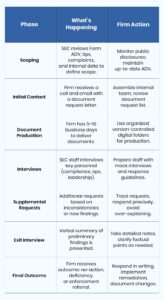Introduction: The Exam That Shaped a Decade
In 2007, the SEC’s examination of a midsize advisory firm uncovered a chain of internal miscommunications that, while not fraudulent, revealed a failure to supervise. It was a turning point. The firm, which had prided itself on ethical transparency, realized too late that good intentions don’t matter when documentation fails. The real lesson? “Pics or didn’t happen”, in this case “pics” being documentation.
Fast-forward to 2025, and the SEC’s Division of Examinations has become more data-driven, more thematic, and more incisive. What used to be a paper-heavy, schedule-disrupting event is now a process sharpened by algorithmic insight, cross-agency collaboration, and thematic sweep exams targeting industry blind spots.
An SEC exam is more of a Pulitzer interview than a pop quiz; and you want to have your footnotes ready. This guide maps the terrain with the insight and specificity compliance professionals actually need.
What Is an SEC Exam, and Why Does It Happen?
Simply put, the SEC conducts examinations to assess whether firms are upholding fiduciary responsibilities and complying with securities laws. They don’t need a reason… but they usually have one.
Routine exams are conducted on a risk-based cycle, because exams may stem from tips, press coverage, or whistleblower complaints. Sweep exams look at industry-wide practices (think: ESG, AI tools, off-channel communications). In 2024, the SEC initiated over 3,000 exams, citing increased risks around cybersecurity, fee transparency, and third-party vendor management.
Real-world trigger: In 2023, a firm using WhatsApp for internal coordination failed to archive client communication. The resulting deficiency letter prompted a seven-figure overhaul of their digital communication policy.
Psychological insight: Anticipation is a stronger motivator than fear. Teams who expect an exam within the next year are more likely to proactively document decisions and test their systems.
How the SEC Selects Firms for Exams
There’s no spinning the wheel here. The SEC uses an internal algorithmic scoring system that weighs factors like:
- size and complexity of assets under management,
- disclosures in Form ADV (especially inconsistencies between Parts 1 and 2),
- past exam history,
- complaints, press coverage, or whistleblower reports,
- emerging risks flagged across the industry.
Firms are rarely told why they were selected, but when you see the document request, it becomes clear.
Pro tip: Conduct a quarterly internal audit comparing your marketing claims with Form ADV language. This one exercise has prevented more exam-day headaches than any other single tactic.
The SEC Exam Process, Step by Step
Scoping the exam
Before you get the call, the SEC has already scoped your risk profile using public filings, press reports, and market signals. This determines whether your exam is focused (one area), limited (a few), or comprehensive (everything).
Initial contact
You’ll receive a phone call and an official letter (usually via email). The letter includes a document request list, often 20+ items long. Your deadline? Typically 5 to 10 business days.
Document production
This is where your preparation pays off. Disorganized firms lose valuable hours here. Savvy ones already have an indexed, digital vault with versioned policies, clean naming conventions, and clear ownership.
Interviews
Compliance officers, operations heads, portfolio managers, and sometimes the CEO will be interviewed. This isn’t a courtroom; but it’s close. Accuracy matters more than polish. It’s okay to say, “Let me confirm that” rather than speculating.
Supplemental requests
These are often the real test. Examiners follow the thread of your answers. If your code of ethics says X, but your trade review logs show Y, expect a request to explain.
Exit interview
The exam team provides a summary of preliminary findings. This is your opportunity to clarify issues, not to argue. Be collaborative, not defensive.
Post-exam results
You’ll receive either:
- A no-action letter
- A deficiency letter (with or without required follow-ups)
- A referral to Enforcement (rare, but serious)
Neuroscience insight: Our brains recall sequences better than isolated facts. Run mock drills that follow the real exam flow, so your team builds procedural memory under stress.
SEC Exam Lifecycle Table
What Documents Should You Have Ready for an SEC Exam?
Organize your vault around these four categories:
- Policies and Procedures: Code of Ethics, Cybersecurity Protocol, Trade Allocation Policy
- Marketing and Advertising: Performance presentations, social posts, slide decks, email campaigns
- Client Records: Investment Management Agreements, KYC docs, risk tolerance assessments
- Operations: Trade blotters, valuation methodology, reconciliation logs
Pro tip: Use version control religiously. The #1 red flag during exams? Multiple conflicting versions of the same policy.
How to Get Ready Before They Call: 3 Vital Steps
The best time to prep for an SEC exam? Way before your inbox lights up with the subject line you’ve been dreading. Panic-mode compliance is easy to spot, and it doesn’t go over well. Examiners pay close attention to whether your systems are actually lived-in or just dusted off once a year. Policies that get updated. Teams that know how to explain what they do and why. Records that match reality.
This section is about building that kind of muscle: through habits, not heroics. Here’s how to get your house in order before anyone knocks.
1. Building a Proactive Compliance Program
A compliance manual gathering dust is worse than no manual at all. Build a culture of iterative compliance: review, revise, reinforce.
Incorporate:
- Quarterly policy updates
- Randomized email reviews for off-channel communications
- Annual compliance training with real-world case studies
- Vendor risk assessments updated bi-annually
2. Conducting Internal Reviews and Mock Exams
Mock exams are your dress rehearsals. Done right, they:
- Reveal documentation gaps
- Uncover contradictory interpretations of policy
- Help employees practice staying calm under questioning
Use outside counsel or a specialized consultant at least once every two years for objectivity.
3. Preparing Your Team
Compliance isn’t one person’s job. Everyone plays a role.
- Hold a firm-wide pre-exam briefing with examples of past questions.
- Assign department liaisons who will support document collection.
- Role-play interviews for managers and client-facing staff.
Remind your team: It’s okay to pause, to check notes, and to ask for clarification. Being “coachable” is a strength, not a weakness.
Common Pitfalls and How to Avoid Them
Let’s call these the Four Horsemen of the Compliance Apocalypse:
- Off-channel communications: If you’re using WhatsApp, Telegram, or Slack, you need an archiving solution. Period.
- Marketing discrepancies: If your pitch deck promises “consistent alpha,” but your ADV talks about volatility, you’re in trouble.
- Custody confusion: Even having password access to a client’s account can trigger custody.
- Supervision gaps: Unreviewed trades, unsupervised reps, or rogue analysts are magnets for examiners.
Pro tip: Keep a “What We Changed” tracker. If you updated your policy because of a deficiency letter or industry trend, document the date, reason, and who signed off. Don’t postpone it, do it right away. That’s gold in an exam.
Responding to Deficiency Letters
A deficiency letter is the SEC’s way of saying: “We found issues you need to fix”. It’s not an enforcement action, but it’s also not something to downplay. Most firms receive some form of deficiency letter after an exam: it outlines where your practices, documentation, or disclosures didn’t meet expectations, and often requests a written response with your remediation plan.
If you receive a deficiency letter:
- Don’t panic!
- Acknowledge receipt promptly
- Draft a written remediation plan with timelines
- Collect evidence of fixes (meeting notes, new policies, attestations)
- Maintain open communication with your SEC point of contact
Strategic note: If the letter includes interpretive ambiguity, work with counsel to clarify before overcommitting to a solution that may backfire.
Conclusion: Readiness Is Not a Checklist
Firms that approach SEC exams as part of their ongoing operations—not as one-off disruptions—tend to build stronger infrastructure over time. An exam highlights how well your internal systems are aligned with your documented policies. It also tests whether your team knows how to execute under pressure.
What matters most is clarity: of roles, records, and reasoning. When your documentation reflects your actual practices, and your team can speak to those practices confidently, you reduce both the risk of findings and the time lost responding to them.
Treat exam readiness like financial reporting: part of your regular cadence, built into how your firm functions, and regularly refined to meet shifting standards. Review, adapt, and improve continuously – not just when you’re under scrutiny. Just like that, you’ll be fine.
Recommended Tools for SEC Exam Readiness
Compliance Management Platforms
- Smartria – Focused specifically on investment adviser compliance workflows; includes policy management, testing schedules, and task delegation features.
- MyComplianceOffice (MCO) – Centralizes conflicts of interest, code of ethics, personal trading, and third-party risk management.
- ComplySci – Great for larger firms needing more control over surveillance, personal trading, and attestation cycles.
Document and Policy Control
- Red Oak Compliance Software – For streamlined marketing material review workflows, especially for firms with heavy advertising footprints.
- LogicGate – GRC platform useful for tracking remediation tasks from deficiency letters and connecting them to documented controls.
- DocuWare or M-Files – Smart document vaults that allow version control, access permissions, and audit trails (critical during document production).
Communication Surveillance
- Global Relay – Captures and archives off-channel communications, including email, Slack, Teams, WhatsApp, and more.
- Smarsh – Offers SEC-compliant archiving and surveillance tools, particularly useful for RIAs integrating multiple communication tools.
- ZL Tech – For firms wanting enterprise-level eDiscovery and internal investigation capabilities.
File Access and Permissions
- Google Drive (Enterprise) – Easy to use with custom folder permissions and versioning; set up read-only folders for exam delivery.
- Egnyte – Offers advanced file governance and compliance controls with real-time alerts on unauthorized access.
- ShareFile by Citrix – Secure file sharing that integrates with compliance tools for clean delivery during SEC exams.
Mock Exams and Training
- ACA Group’s Mock Exam Services – Used by hundreds of firms to simulate SEC exams with real pressure, red-flag tracking, and written reports.
- IAR Ethics & Compliance Toolkit – Provided by the Investment Adviser Association; includes templates and training scripts.
- Navex – Not compliance-specific but excellent for policy rollout, attestation, and training tracking at scale.



